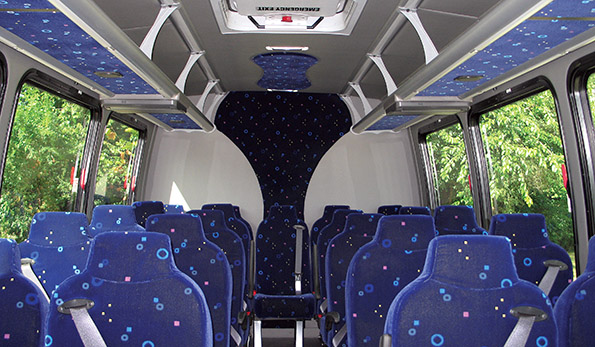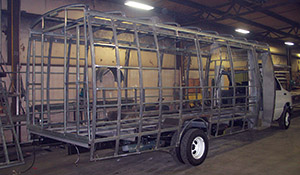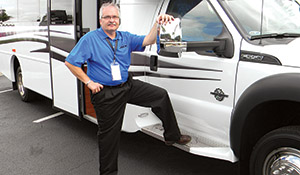
The company is on track with new production facility and product improvements
By David Hubbard
The plan is progressing since ABC Companies, Faribault, MN, acquired the TMC Group, Elkhart, IN, and the Ameritrans brand in 2012. This step was made to both diversify ABC Companies’ product range to include a midsize cutaway and add a manufacturing component to the business.
According to Barry Hines, general manager, Ameritrans Bus, Inc., with the expansion of the manufacturing facility, the company is now set to go. The project includes the recent annex of an additional 60,000 square-foot building about a block away from the existing facility.
“Between the paint shop we own, the existing building and the new space next door, we now occupy about 120,000 square feet of vehicle production space,” Hines says. “That’s up from the 55,000 square feet we started with.”
The larger space, comprising four separate plants, accommodates the structural and skinning operation, paint shop and final fit and finish of the new line.

“This is the line we showed at BusCon last year,” says Del Littrell, Ameritrans lead engineer. “We are out with new body styles and interior appointments. We are also getting a lot of comment on the tight construction and quiet ride.”
Littrell says the significant style changes are akin to what has taken place in the automotive industry over the last several years.
“We have improved upon the look of Ameritrans buses,” he says. “The updated design brings our models in line with current trends.”
He points to the smallest model in the line, the E Series, which features a totally new look. The design changes actually provide 10 inches more lateral head and shoulder room for passengers, as well as bigger windows and an all-enclosed entry. The door is flush with the outside; nothing protrudes.
“On the older buses, six inches of the first step at the entry extend outside and was always exposed to the weather,” Littrell says. “That has been eliminated with the entry steps fully enclosed.”
According to Littrell, Ameritrans is also the only small bus OEM to extend the steel cage structure below the floor line. Ameritrans’ extends below the floor and behind the skirt.
Hines says the bigger buses ranging from 33 to 42 feet, particularly the Ford F330, Ram R330 and Freightliner M2, are taking Ameritrans to new places in the market.
“We are meeting more motorcoach operators wanting to maintain the interior look and comfort of a full-size coach in a smaller vehicle,” he says. “They don’t always fill their large coaches and it doesn’t make economic sense to transport small groups in large buses.”
Ameritrans National Sales Manager Mike DeMarco says demand for the larger R330 and F330 has increased significantly.
“We are able to bring the big feel to the larger midsize bus,” he says. “The HVAC and coach seating are the same, and we can fit the luggage storage overhead, in the rear compartment or underfloor. This coach feel comes at about two-thirds the cost of a full-size coach.”
According to DeMarco, Ameritrans builds intentionally to the high-end luxury market.
“We build comfortable quiet buses for the retail customer,” he says. “We strive to engineer more of a coach experience into the small bus structure. We recently delivered a nicely equipped Freightliner to Boeing Aircraft in Seattle, WA, and another to a major tech company for use as an employee shuttle.”
The company says it has no intention of marketing to public agencies for transit services such as paratransit or on on-demand shuttle services that typically employ small and midsize buses.
Littrell says a number of visitors to the Ameritrans display during BusCon in September went so far to say the company has “redefined the shuttle bus as we know it.”
“Whether that is true or not, we attribute the changes to the input we have received from our dealers,” DeMarco says. “Their comments and observations are coming from what they hear from their customers.”
Once thought of as a quietly run company with limited distribution, the Ameritrans dealer network is making itself known with sales representatives extending into all 50 states.
“Today, we have dealerships that now stock Ameritrans vehicles to show and demo,” DeMarco says. “Before, they would refer to printed materials or promotional literature to secure an order. The model choices they have are the most closely related to the needs of their customers.”

Hines says because Ameritrans products are more expensive than other brands, it is easier for potential buyers to see and understand the difference in pricing.
“Without the bus on hand to test drive and experience, a dealer has a more difficult time explaining why the higher price exists,” he says. “In the broadbrush look across the country, we are seeing an even mix between the smaller and larger models they are choosing to keep in stock.”
He says it is fairly evenly balanced with the 28-foot to 39-foot models accounting for the core business.
“In addition to the standard charter and shuttle applications, we are starting to see motorcoach charter tour operators sizing up the new Ameritrans models,” Hines says. “The larger F and R series are catching on.”
Hines says the company is also receiving inquiries for specialty applications requiring 4X4 drive.
“This would be for operators needing something just a little more rugged to handle the conditions,” he says. “It might be used in mining and construction companies, or winter resorts with snowy roads.”
He says the company is already working on a few orders, which they will begin on this summer.
Though not the largest, churches are turning out to be an important market niche for Ameritrans, due mostly to active dealerships such as Carpenter Bus, Franklin, TN, and Davey Coach, Sedlia, CO. The company estimates that the church market currently represents about 5 to 7 percent of its sales, but expects this niche to grow.
“The bigger churches throughout the country are looking at premium buses for group transport,” Hines says. “We have some delivered, and some high-end units currently on the line that are going to churches.”
An upshot to all of this, DeMarco says is that Ameritrans is enjoying quite a bit of repeat business.
“If this is due to a cycle, this year we seem to be on the upward swing,” he says. “Manufacturers will typically see a large influx of orders as buses reach the end of their life cycles. The average life cycle for most small buses is about five years. The new models with all the improvements in design and engineering will most likely stretch to 10 years.”
